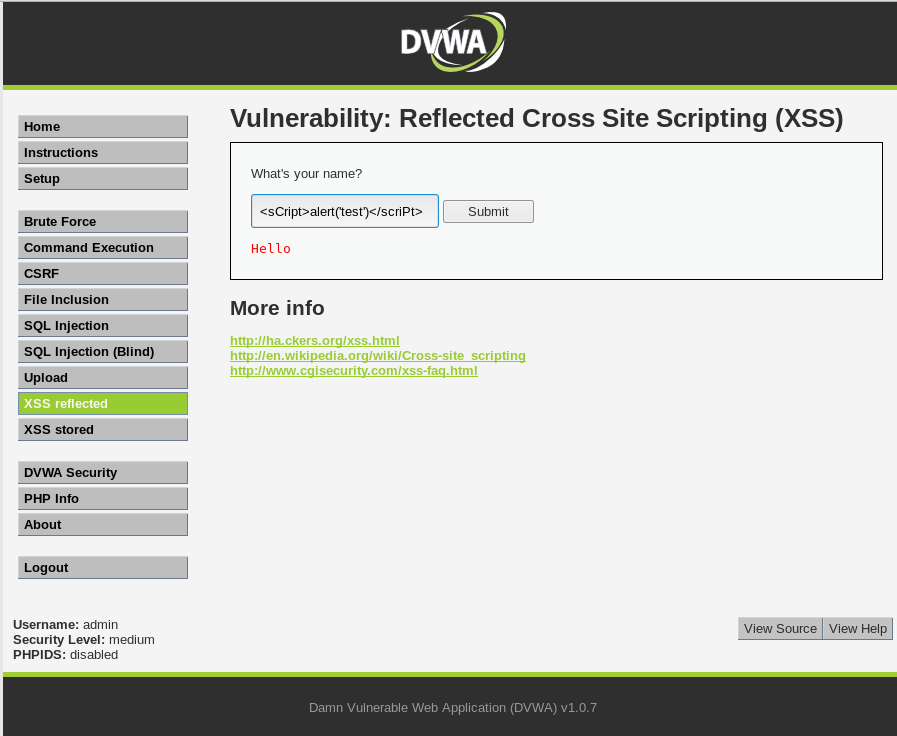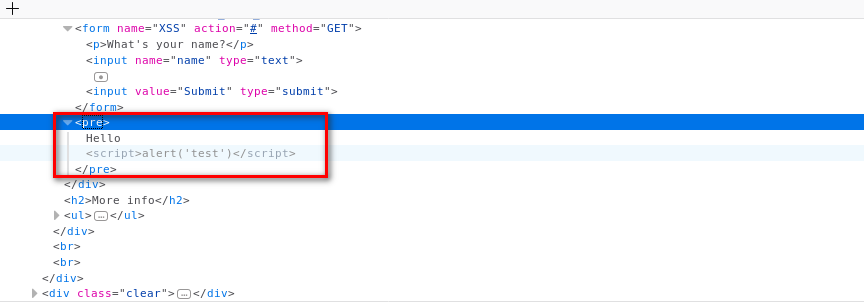Python Ethical Hacking - VULNERABILITY SCANNER(7)
VULNERABILITY_SCANNER
How to discover a vulnerability in a web application?
1. Go into every possible page.
2. Look for ways to send data to the web application(URL + Forms).
3. Send payloads to discover vulnerabilities.
4. Analyze the response to check of the website is vulnerable.
->General steps are the same regardless of the vulnerability.
Login the metasploitable VM and modify the security of DVWA from high to medium.(dvwaPage.inc.php in /var/www/dvwa/dvwa/includes)

Submit the following script on the Reflected Cross Site Scripting(XSS)
<sCript>alert('test')</scriPt>

You can find the script in the source code.

Add the new feature - test_xss_in_form in Scanner class.
#!/usr/bin/env python import requests
import re
from bs4 import BeautifulSoup
from urllib.parse import urljoin class Scanner:
def __init__(self, url, ignore_links):
self.session = requests.Session()
self.target_url = url
self.target_links = []
self.links_to_ignore = ignore_links def extract_links_from(self, url):
response = self.session.get(url)
return re.findall('(?:href=")(.*?)"', response.content.decode(errors='ignore')) def crawl(self, url=None):
if url == None:
url = self.target_url
href_links = self.extract_links_from(url)
for link in href_links:
link = urljoin(url, link) if "#" in link:
link = link.split("#")[0] if self.target_url in link and link not in self.target_links and link not in self.links_to_ignore:
self.target_links.append(link)
print(link)
self.crawl(link) def extract_forms(self, url):
response = self.session.get(url)
parsed_html = BeautifulSoup(response.content.decode(), features="lxml")
return parsed_html.findAll("form") def submit_form(self, form, value, url):
action = form.get("action")
post_url = urljoin(url, action)
method = form.get("method") inputs_list = form.findAll("input")
post_data = {}
for input in inputs_list:
input_name = input.get("name")
input_type = input.get("type")
input_value = input.get("value")
if input_type == "text":
input_value = value post_data[input_name] = input_value
if method == "post":
return requests.post(post_url, data=post_data)
return self.session.get(post_url, params=post_data) def run_scanner(self):
for link in self.target_links:
forms = self.extract_forms(link)
for form in forms:
print("[+] Testing form in " + link) if "=" in link:
print("[+] Testing " + link) def test_xss_in_form(self, form, url):
xss_test_script = "<sCript>alert('test')</scriPt>"
response = self.submit_form(form, xss_test_script, url)
if xss_test_script in response.content.decode():
return True
Modify the vulnerability scanner code and test it.
#!/usr/bin/env python import scanner target_url = "http://10.0.0.45/dvwa/"
links_to_ignore = "http://10.0.0.45/dvwa/logout.php" data_dict = {"username": "admin", "password": "password", "Login": "submit"} vuln_scanner = scanner.Scanner(target_url, links_to_ignore)
vuln_scanner.session.post("http://10.0.0.45/dvwa/login.php", data=data_dict) # vuln_scanner.crawl()
forms = vuln_scanner.extract_forms("http://10.0.0.45/dvwa/vulnerabilities/xss_r/")
print(forms)
response = vuln_scanner.test_xss_in_form(forms[0], "http://10.0.0.45/dvwa/vulnerabilities/xss_r/")
print(response)
Aha! We find customized vulnerability.

Python Ethical Hacking - VULNERABILITY SCANNER(7)的更多相关文章
- Python Ethical Hacking - VULNERABILITY SCANNER(9)
Automatically Discovering Vulnerabilities Using the Vulnerability Scanner 1. Modify the run_scanner ...
- Python Ethical Hacking - VULNERABILITY SCANNER(4)
Extracting & Submitting Forms Automatically Target website:http://10.0.0.45/dvwa/vulnerabilities ...
- Python Ethical Hacking - VULNERABILITY SCANNER(2)
VULNERABILITY_SCANNER How to discover a vulnerability in a web application? 1. Go into every possibl ...
- Python Ethical Hacking - VULNERABILITY SCANNER(8)
Implementing Code To Discover XSS in Parameters 1. Watch the URL of the XSS reflected page carefully ...
- Python Ethical Hacking - VULNERABILITY SCANNER(3)
Polish the Python code using sending requests in a session Class Scanner. #!/usr/bin/env python impo ...
- Python Ethical Hacking - VULNERABILITY SCANNER(1)
HTTP REQUESTS BASIC INFORMATION FLOW The user clicks on a link. HTML website generates a request(cli ...
- Python Ethical Hacking - VULNERABILITY SCANNER(6)
EXPLOITATION - XSS VULNS EXPLOITING XSS Run any javascript code. Beef framework can be used to hook ...
- Python Ethical Hacking - VULNERABILITY SCANNER(5)
EXPLOITATION - XSS VULNS XSS - CROSS SITE SCRIPTING VULNS Allow an attacker to inject javascript cod ...
- Python Ethical Hacking - BACKDOORS(8)
Cross-platform hacking All programs we wrote are pure python programs They do not rely on OS-specifi ...
随机推荐
- RockeMQ安装与入门
淘宝内部的交易系统使用了淘宝自主研发的Notify消息中间件,使用Mysql作为消息存储媒介,可完全水平扩容,为了进一步降低成本,淘宝开发团队认为存储部分可以进一步优化,2011年初,Linkin开源 ...
- java map里面进行ASCII 码从小到大排序(字典序)
public static String getAsciiSort(Map<String, Object> map) { List<Entry<String, Object&g ...
- 使用 Masstransit中的 Request/Response 与 Courier 功能实现最终一致性
简介 目前的.net 生态中,最终一致性组件的选择一直是一个问题.本地事务表(cap)需要在每个服务的数据库中插入消息表,而且做不了此类事务 比如:创建订单需要 余额满足+库存满足,库存和余额处于两个 ...
- VulnHub PowerGrid 1.0.1靶机渗透
本文首发于微信公众号:VulnHub PowerGrid 1.0.1靶机渗透,未经授权,禁止转载. 难度评级:☆☆☆☆☆官网地址:https://download.vulnhub.com/power ...
- liunx中组合查询的命令
今天无聊,把以前的liunx命令拿过练练,尤其是一些组合命令并带有逻辑的.这里的script是一个文件夹. 1.查看一个文件的最后3行的第一行. [root@localhost home]# tail ...
- Redis高级特性
redis的事务(transaction) 转载:https://blog.csdn.net/fmwind/article/details/78065236 redis中的事务是一组命令的集合.事务同 ...
- win10 麦克风无法使用,可能是设置了权限
驱动什么的都正常,平白无故麦克风不好用了,原来是之前自己设置了麦克风权限: 把这个开关打开就可以了. (完)
- Spring中AOP相关的API及源码解析
Spring中AOP相关的API及源码解析 本系列文章: 读源码,我们可以从第一行读起 你知道Spring是怎么解析配置类的吗? 配置类为什么要添加@Configuration注解? 谈谈Spring ...
- 调试HotSpot源代码
之前的文章在Ubuntu 16.04上编译OpenJDK8的源代码 已经介绍过在Ubuntu上编译OpenJDK8的源代码,这一篇将介绍在Ubuntu上调试OpenJDK8源代码的2种方式. 1.GD ...
- 如何基于 echarts 实现区间柱状图(包括横向)?
目录 需求 借鉴 echarts 的 demo 最终实现思路 实现效果 遇到的问题: 代码映射 源码 最后 始终如一 需求 需要利用 echarts 实现区间柱状图,效果如下: 效果来源于:g2-柱状 ...
